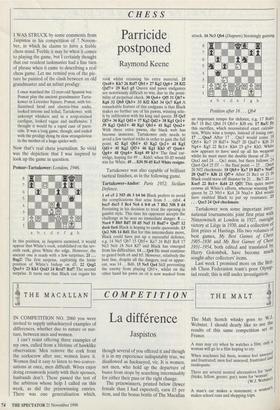CHESS
Parricide postponed
Raymond Keene
I WAS STRUCK by some comments from Jaspistos in his competition of 7 Novem- ber, in which he claims to have a feeble chess mind. Feeble it may be when it comes to playing the game, but I certainly thought that our resident taskmaster had a fine turn of phrase when it came to describing a real chess game. Let me remind you of the pic- ture he painted of the clash between an old grandmaster and an infant prodigy:
I once watched the 12-year-old Spanish boy Pomar play the ancient grandmaster Tarta- kower in Leicester Square. Pomar, with bri- lliantined head and electric-blue socks, looked intense and lethal; Tartakower with unkempt whiskers and in a soup-stained cardigan, looked vague and inoffensive. I thought it would be a rapid case of parri- cide. It was a long game, though, and ended with the prodigy dying by slow strangulation in the meshes of a huge spider-web.
Now that's real chess journalism. So vivid was the depiction that I was inspired to look up the game in question.
Pomar—Tartakower: London, 1946.
In this position, as Jaspistos surmised, it would appear that White's rook, established on the sev- enth rank, gives White the edge. However, the ancient one is ready with a few surprises. 21 ... Bxg2! The first surprise, exploiting the loose position of White's bishop on d3. 22 Qxg2 Qxe3+ 23 Khl Qxd3 24 Rcxf7 Rxf7 The second surprise. It turns out that Black can regain his rook whilst retaining his extra material. 25 QxaS+ Kh7 26 Rxf7 Qbl+ 27 Kg2 Qg6+ 28 Kf2 Qxf7 + 29 Ke3 g5 Queen and pawn endgames are notoriously difficult to win, due to the possi- bility of perpetual check. 30 Qe4+ Qf5 31 Qb7+ KO 32 Qb8 Qh3+ 33 Kf2 Kh5 34 Qc7 Kg4 A remarkable feature of this endgame is that Black makes no further use of his pawns, winning sole- ly by infiltration with his king and queen. 35 Qe5 Qf3+ 36 Kg1 Qdl+ 37 Kg2 Qd2+ 38 Kgl Qcl+ 39 Kg2 Qxb2+ 40 Kg1 Qbl+ 41 Kg2 Qxa2+ With three extra pawns, the black web has become immense. Tartakower only needs to avoid a few tactical tricks in order to gain the full point. 42 Kg1 Qbl+ 43 Kg2 Qc2+ 44 Kg1 Qdl+ 45 Kg2 Qf3+ 46 Kg1 ICh3 47 Qxe6+ Qg4+ 48 Qxg4+ Kxg4 49 h3+ The final car- tridge, hoping for 49 ...10ch3, when 50 d5 would win for White. 49 ...Kf4 50 d5 Ke5 White resigns.
Tartakower was also capable of brilliant tactical finishes, as in the following game.
Tartakower—Andor: Paris 1952; Sicilian Defence.
1 e4 c5 2 Nf3 d6 3 b4 b6 Black prefers to avoid the complications that arise from 3 ...catb4. 4 bxc5 dxc5 5 Bc4 Nc6 6 0-0 e6 7 Bb2 Nf6 8 d4 Persisting in his decision to treat the opening in gambit style. This time his opponent accepts the challenge as he sees no immediate danger. 8 ... Nxe4 9 Bb5 Bd7 10 d5 Na5 11 Bxd7+ Qxd7 12 dxe6 fxe6 Black is hoping to castle queenside. 13 Qe2 Nf6 14 Rdl But for this intermediate move, Black could have put up a successful defence, e.g. 14 Ne5 Qb7 15 Qb5+ Ke7 16 Rdl Rc8 17 Nc3 Nc6 18 Nc4 Kf7 and Black has emerged from his difficulties. 14 ... Qc6 He must continue to guard both e6 and b5. However, relatively the best line, despite all the dangers, real or appar- ent, was 14 ... Bd6. 15 Ne5 Qa4 Still preventing the enemy from playing Qb5+, whilst on the other hand his pawn on e6 is now masked from attack. 16 Nc3 Qb4 (Diagram) Seemingly gaining an important tempo for defence, e.g. 17 Rabl Bel 18 Bal Qh4 19 Qb5+ Kf8 etc. 17 Ba3! BY this sacrifice, which necessitated exact calcula- tion, White wins a tempo, instead of losing one. 17 ... Qxa3 After 17 ... Qxc3 would come 18 Qb5+ Ke7 19 Rd7+ Nxd7 20 Qxd7+ Kf6 21 Ng4+ Kg5 22 Bcl+ Kh4 23 g3+ Kh3. White now appears to have used up all his weapons whilst he must meet the double threat of 24 . • • Qxa 1 and 24 ... Qel mate, but there follows: 24 Qxe6 Qc4 25 f3! — the final point — 25 ...0xe6 26 Nf2 checkmate. 18 Qb5+ Ke7 19 Rd7+ Nxd7 20 Qxd7+ Kf6 21 Qf7+ After 21 Rel or 21 f4 Black could stave off disaster by 21 ...Be7. 21 KxeS 22 Rel+ Kd4 23 Qf3! This quiet move crowns all White's efforts, whereas winning the queen by 23 Nb5+ Kc4 24 Nxa3+ KM would have enabled Black to put up resistance. 23
Qxc3 24 Qe4 checkmate.
Tartakower won some important inter- national tournaments: joint first prize with Nimzowitsch at London in 1927, outright victory at Liege in 1930, and a collection of first prizes at Hastings. His two volumes of best games, My Best Games of Chess 1905-1930 and My Best Games of Chess 1931-1954, both edited and translated by Harry Golombek, have become much sought-after collectors' items. Last week I promised more on the Wit' ish Chess Federation team's poor Olyhe iad result; this is still under investigation.


















































































 Previous page
Previous page